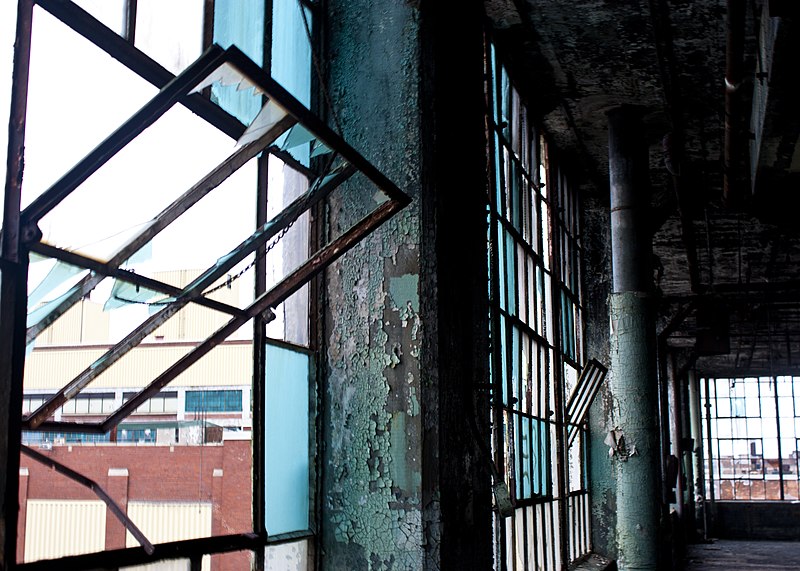Plate glass
Contents |
[edit] Introduction
Glass is a material made from liquid sand. It is an amorphous (non-crystalline) solid that displays a glass transition near its melting point which is around 1,700°C (3,090°F). This means that materials transform from a hard and brittle state into a molten state, or vice versa depending on whether the glass transition temperature is the melting or solidifying point. An amorphous solid has some of the crystalline order of a solid and some of the random molecular structure of a liquid.
There are many types of glass, each with different chemical and physical properties dependent upon their application.
For more information see: Glass.
[edit] History of plate glass
Plate glass is a type of glass that was first produced in plane form. The earliest successful version of plate glass was manufactured in France in the 17th century. It was an improvement over the cylinder glass or broad glass method, which required the glass maker to swing a bubble of molten glass back and forth whilst blowing, producing an elongated balloon that could be formed into the shape of a cylinder and then flattened into a sheet.
For more information, see Cylinder glass
The advance plate glass process was introduced by Louis Lucas de Nehou and Abraham Thevart. It involved casting the molten material onto a metal table and then grinding and polishing the glass by hand.
For more information, see Cast plate
This technique was automated in the 1800s when a steam engine took over the grinding and polishing process. The process improved again in the early 1900s, when machines were designed to incorporate methods including the Fourcault process, the Bicheroux process and others. Using these methods, plate glass could be manufactured in various weights and thicknesses. It was colourless and had good transparency, which is why it was once commonly used for large picture windows and glass doors.
[edit] Imperfections and distortions
While it was produced with a smooth finish, plate glass was not always entirely flat or parallel. This sometimes produced a slight distortion effect. Once float glass was introduced in the 1950s, plate glass became less popular.
Float glass created large, thin, flat panels from molten glass that were then floated onto a pool of molten metal such as tin. This process produced a very smooth sheet of glass with a highly consistent thickness.
For more information see: Float glass.
[edit] Related articles on Designing Buildings Wiki
Featured articles and news
RTPI leader to become new CIOB Chief Executive Officer
Dr Victoria Hills MRTPI, FICE to take over after Caroline Gumble’s departure.
Social and affordable housing, a long term plan for delivery
The “Delivering a Decade of Renewal for Social and Affordable Housing” strategy sets out future path.
A change to adoptive architecture
Effects of global weather warming on architectural detailing, material choice and human interaction.
The proposed publicly owned and backed subsidiary of Homes England, to facilitate new homes.
How big is the problem and what can we do to mitigate the effects?
Overheating guidance and tools for building designers
A number of cool guides to help with the heat.
The UK's Modern Industrial Strategy: A 10 year plan
Previous consultation criticism, current key elements and general support with some persisting reservations.
Building Safety Regulator reforms
New roles, new staff and a new fast track service pave the way for a single construction regulator.
Architectural Technologist CPDs and Communications
CIAT CPD… and how you can do it!
Cooling centres and cool spaces
Managing extreme heat in cities by directing the public to places for heat stress relief and water sources.
Winter gardens: A brief history and warm variations
Extending the season with glass in different forms and terms.
Restoring Great Yarmouth's Winter Gardens
Transforming one of the least sustainable constructions imaginable.
Construction Skills Mission Board launch sector drive
Newly formed government and industry collaboration set strategy for recruiting an additional 100,000 construction workers a year.
New Architects Code comes into effect in September 2025
ARB Architects Code of Conduct and Practice available with ongoing consultation regarding guidance.
Welsh Skills Body (Medr) launches ambitious plan
The new skills body brings together funding and regulation of tertiary education and research for the devolved nation.
Paul Gandy FCIOB announced as next CIOB President
Former Tilbury Douglas CEO takes helm.
UK Infrastructure: A 10 Year Strategy. In brief with reactions
With the National Infrastructure and Service Transformation Authority (NISTA).























